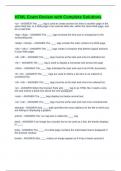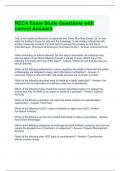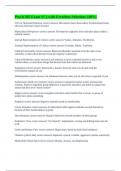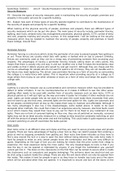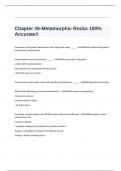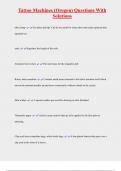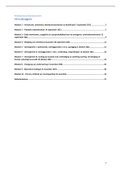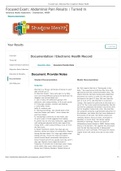Chapter 1: Project Management
Process = constitution of links between activities and the transformation that takes place within the
process.
- Characteristics: 1) definability (clear boundaries, input, output), 2) order (activities ordered in
time/space), 3) customer (recipient of process outcome), 4) value-adding (upstream or downstream),
5) embeddedness (in org. structure, process cannot exist in itself), 5) cross-functional.
Project = temporary endeavor undertaken to create unique product/service/result. Has a budget and
resources.
- Characteristics: 1) temporary activities with start and end, 2) restricted resources, 3) goal(s), 4)
develops single and new output, 5) budget, 6) project manager responsible for coordinating activities.
Project are charted and authorized because of market demand, business need, customer request,
technological advance, legal requirement or social need.
Project Management tracking process’ execution from schedule and cost perspective.
Chapter 2: Project Organizations
Want to achieve technologically and economically the best results in the development of continuously
more complex and organizational problem-solving strategies.
It is uncertain (challenging, dangerous) to implement project teams within the organization, because
the fulfillment of a project task has usually never been achieved before.
Organizational structure needs to fit with the requirements of the
project and the organization, with the possible requirements as
well as technological opportunities of the future and has to
balance technological and human-social factors. Identify prior to
project start the internal and external requirements.
Structural organization = internal distribution of tasks to
individuals/departments (how the organization is structured
internally within the project team) + relationships between
individuals/departments (How a project organization is
embedded within the parent organization).
Operational structure = dynamic, when where and how often
something has to be done.
Project sponsor = manager/executive within organization who is not directly involved in the
operational work of the project but who can oversee project, delegate authority to Project Manager and
provides support as a trainer/coach to Project Manager.
- Has sufficient authority/influence to direct all staff involved in the project.
- Can cooperate with key stakeholders.
- Ensures project is aligned with organizational strategy/compliant with policy.
Steering Committee = group of senior managers responsible for business issues affecting the project.
Assists with resolving strategic level issues/risks, can approve/reject changes to project and assesses
progress and report to senior management/higher authorities.
- Budget approval authority.
- Make decisions about changes in goal/scope.
, - Highest authority to resolve issues/disputes.
- Advice and guidance on business issues, use influence and authority to assist project in
achieving its outcomes.
Project governance is carried out by the project sponsor + steering committee. Governance = all
activities and processes which ensure that directors and managers act in the interests of the
organization and are accountable for their use of those assets. Project documents, status reports.
Advisory committee = group of people that represents key project stakeholders and provides advice to
the project. Can not make decisions, just insights regarding stakeholder interests, technical advice and
initiatives.
Project manager = key person which has overall responsibility for meeting project requirements within
agreed time, cost, scope and quality constraints.
- Supervision and guidance to project team.
- Regular project status reports to project sponsor/steering committee.
- Attend steering committee meetings and prepare supporting materials with project sponsor.
- Execute project processes: risk, issues, change, quality and document management.
- Ensure project plan, schedule and budget up-to-date.
Team leader = responsible for managing one part of a project/subproject. Only in large projects.
Reviews all sub-team deliverables, hold regular sub-team status meetings and provides status reports
to the project manager.
- Team member: assigned to a team who is responsible for performing a clearly defined part of the
project activities.
Organizational models (way of organizing projects within parent organization)
1. Project as part of the functional organization (pure line
organization).
No specific position for project manager. Project manager is
specialist/line manager who is aligned to project for a specific time.
Project is divided into partial tasks and delegated to responsible
departments. Team members continue to report to
line-directors/upper managers.
Advantages:
- Reduced overhead (no additional team member has to be
hired).
- Clearly marked career paths for hiring & promotion.
- Employees work alongside colleagues who share similar interests (expertise per department).
- No structural change for running the project required.
- Flexibility for changes in project scope.
- Easy post-project transition (do their line job again after project.
Disadvantages:
- Co-ordination of functional tasks difficult (little reward for co-operation with other
departments, authority is with functional supervisor).
- Provides scope for different department heads to pass off company project failures as being
due to failures of other departments.

